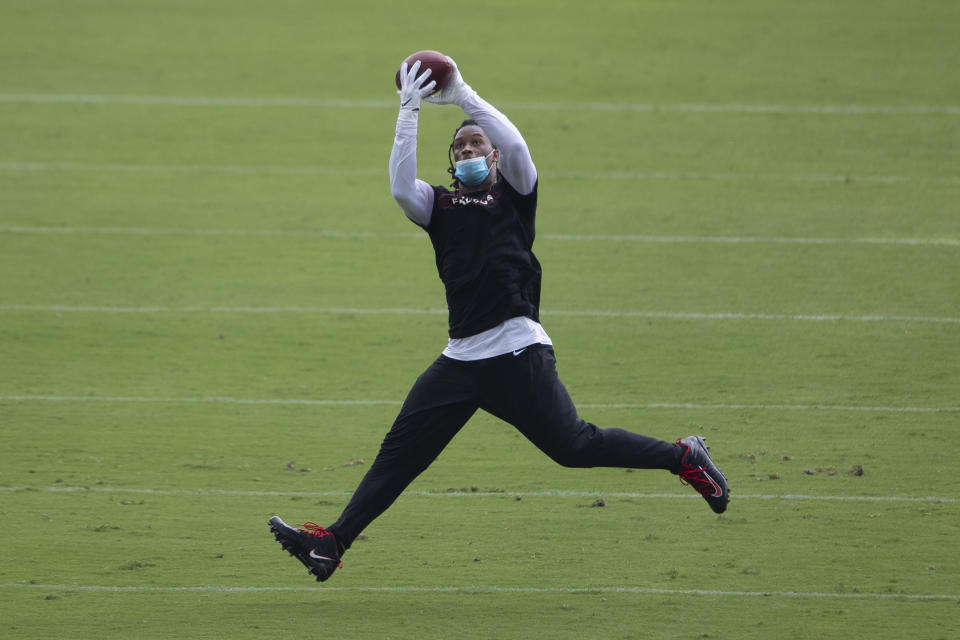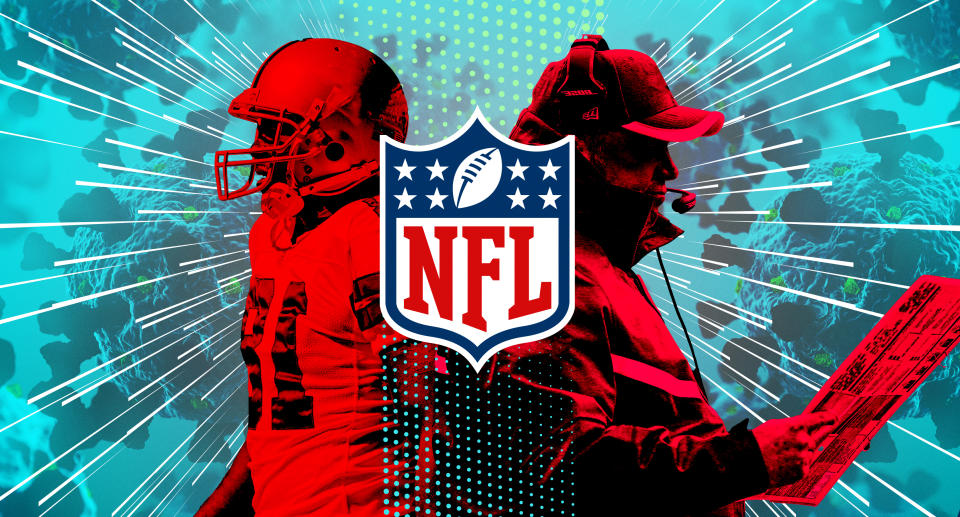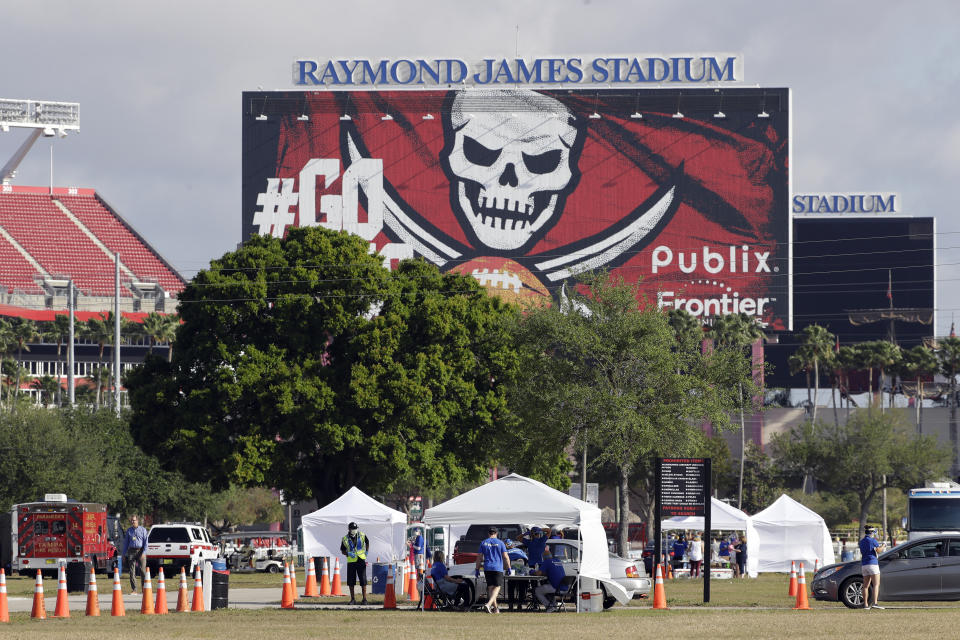NFL training camps during COVID: An unused snitch line, coaches breaking rules and bacon boxes
The plan was clearly spelled out.
Arrows on the floors. Traffic goes one way through small spaces. Always wear your mask and GPS tracker. Show up early to get the COVID-19 nasal swabs. Sanitize your hands, sanitize your hands, sanitize your hands. Don’t congregate. Create a personal bubble. Follow the rules in the facility, and then let the rules follow you home, too.
After all, nobody wants to be like the Miami Marlins.
One week of jumping through the NFL’s preventative hoops inside team facilities has been interesting, if not repetitive. One team employee called it “Groundhog Day.” Another compared the rigid set of protocols and reliance on technology “like living in ‘Blade Runner’ or ‘The Island’.” Not to mention a dash of George Orwell’s dystopian “1984,” thanks to GPS trackers that log contact between employees and constantly monitor whether they’re keeping a proper distance from each other.
“They track you through walls, too,” one team employee said. “We have a lot of temporary walls up now because of the COVID layout, and sometimes you’ll be by yourself and your tracker lights up because you’re sitting or standing too close to someone who is on the other side of a wall. We’re not even in the same room.”
That’s just one of the oddities of a bubble-less NFL trying to create a clean zone. And there have been more than a few already, with some teams just more than a week into the grand endeavor to keep the 2020 season on track.

Yahoo Sports spoke to 11 NFL team employees in different franchises, asking each to do a verbal walkthrough of their typical day since facilities opened. Overlapping those experiences, a tapestry emerged showing considerable rules and efforts that are being undertaken. But there are also some soft spots ... not to mention an abundance of monotony that will almost certainly become a significant challenge as the efforts are (hopefully) forced to stretch on for the next six months.
Some notable common themes (both good and bad) ...
Some coaches have been the biggest rule-benders
One team employee may have summed it up best: “I could have probably reported [my head coach] 10 times by now for doing things he’s not supposed to be doing.”
Not every staffer griped about the coaching staff. But several said that coaches tend to be the ones who either skirt some of the rules inside the facility or ignore them altogether. And much like the outside world, the people who are being asked to follow the rules as strictly as possible are noticing others who don’t. From multiple accounts, the “others” are often on the coaching staff.
“[The head coach] goes the opposite way of the [hallway] arrows all the time. I don’t think he even pays attention to them,” one team employee said. “He was hugging all the players when they first got in [to the facility]. He’s close to people pretty much all the time. He’s definitely the biggest rulebreaker. Pretty much everyone else is following the rules. Even the players have been really good about it. But a lot of the coaches are doing things they’re not supposed to.”
Added another team employee, “The coaches, it’s always going to be looser with the rules. We have some coaches who don’t even believe this is a real thing, so you know those guys aren’t going to be following everything.”
And another: “I’ve seen our defensive coaches with their masks pulled down, working like shoulder-to-shoulder together. Which, you know, we’ve been told over and over to absolutely not do that. I don’t even know how that’s possible with the GPS [trackers], unless they haven’t been keeping them on.”

Everyone is getting some version of ‘The Marlins Talk’
Every team employee — all 11 surveyed — said they heard some mention of the Marlins when stressing safety. The instances have varied, whether occurring in a staff meeting, daily email or just in passing during the course of the day. The point was rooted in the same motivation.
Basically, the Marlins (and in some instances, Major League Baseball) have been leveraged as the horror story to remind employees how easily everything can be blown up if just one person stops following the rules. The revelation of the Minnesota Vikings’ infection control officer testing positive for COVID-19 was also a topic raised by multiple teams.
“[Our general manager] told us that we have to make our own personal bubble and be responsible for it,” one employee said. “He said, ‘You take your bubble everywhere you go, so always think of it that way when you’re going to do something that lets something inside your bubble.’”
“[The Marlins talk] was pretty much just ‘Don’t be that guy,’” another team employee said. “Don’t be the one who blows it for everyone.”
Some teams have a ‘snitch’ line
A few teams have set up a phone number that employees can call if they want to report protocols being broken or other concerns.
“We call it a ‘COVID help line’ but it’s a snitch line,” one employee said.
Asked if they would consider calling it, the employee laughed and said, “Hell, no. I’m not calling that thing. I doubt anyone will ever call it. It’s supposed to be anonymous, but I wouldn’t take that chance.”
Another employee said they have been instructed to report protocol issues but given no structure for how to do it.
“We were told that if we see something that we should say something,” the employee said. “But I don’t even know how that’s supposed to work. I don’t even know who I’m supposed to tell.”
There is some ‘tier envy’
With teams divided into three tiers, it has compartmentalized teams more than usual.
“Tier 1” is a very limited group, composed of coaches, players, athletic trainers and medical personnel who require first-person access to players and all restricted areas.
“Tier 2” is slightly less limited, but includes general managers, front-office employees, operations, video, security and others who still have access to certain restricted areas.
“Tier 3” are other types of personnel involved in franchise or stadium operations, who provide some services that don’t require access to Tier 1 personnel or all restricted areas to perform their jobs.
Only a week in, any employee you speak with knows precisely where they can or can’t be in the building. As one would expect, there has been some (gentle) grousing from some Tier 2 and 3 employees who don’t have unfettered access to parts of the building. More often than not, the complaints stem from routines being disrupted or access to some equipment or rooms that no longer exists.
Workout areas are one of the bigger gripes, as most team employees have some level of free access to exercise facilities — which can be a considerable perk, especially when you’re not allowed to go to a public gym (or sometimes even an apartment gym) under the current COVID measures.
Nobody is losing their minds over the restrictions, of course. However, there is also some inequity when it comes to how the rules have been related. Some Tier 2 and Tier 3 employees have complained about feeling brusquely and repeatedly lectured about not slipping up inside or outside of the facility — while they see some Tier 1 individuals (like coaches) not being held to the same standard of accountability.
It was also noted by a few Tier 2 and 3 employees that they have never been offered an “opt out” option like the players, leaving them to feel like they would lose their jobs if they sat out the 2020 season.
The day begins early and with a questionnaire
Most employees said they wake up as early as 4 a.m. and check their email or phone app for a questionnaire or survey that has to be completed before being allowed to show up to the facility. Some get their results as part of the next day’s questionnaire. Others have been told that they will be informed of their test results only if they test positive for COVID.
Employees essentially answer a series of stock questions about whether they have a fever, headache or sore throat. If their answers don’t raise a flag, they get the green light to come to the facility parking lot, where a testing trailer is set up.
The basic steps that overlapped for most franchises: wake up and take the questionnaire; proceed to the lot and sign in; find a booth in a trailer and take the COVID swab test; proceed inside and pick up a GPS tracker; and finally, go to work.
If, for some reason, the morning questionnaire is flagged, that employee will be contacted immediately and told not to come to the facility. At that point, the team will get the employee a COVID test while keeping others safe in the process.
At least one team has had a technical malfunction that left a handful of employees waiting in the parking lot for several hours, while the previous day’s testing results were located.

Testing has been a nasal swab roulette
Some teams have done only nasal swab testing. Some clubs have done nasal swabs and bloodwork to check for COVID-19 antibodies. Everybody has been consistent about doing the testing every day.
Some employees who have done work at home still have to come on site for their testing every day. Interestingly, working at home has been encouraged in many franchises in situations where an employee doesn’t have something that mandates them being inside the facility. Employees are also being told to wrap up early and get out of the building when they are done with work — which is unusual for teams that typically never discourage long hours inside the facilities.
As for the nasal testing, it can change from one day to the next depending on who is doing the testing. It should be noted that there are different procedures for different kinds of nasal tests — and some are less invasive (and uncomfortable) than others.
“The first time I did it, the girl put the swabs way in there and then counted to 10 for each [nostril],” an employee said. “It was terrible. I couldn’t believe I was going to have to do that every day. But then the next few times, it was just like a quick swipe and I was out. No count or anything.”
Two team employees said their franchises had someone test positive for COVID antibodies — with the person having no idea they had previously been infected. In both cases, the employee had virtually no contact with their team due to the virtual offseason program. The virtual program likely kept those individuals from infecting others in the franchise over the previous several months.
Bacon boxes
Teams have different setups, but they’re all predicated on keeping people away from each other when they eat. Some teams have removed half of their tables in the cafeteria and tried to distance anyone sitting at the tables.
Others have eliminated anyone but the players eating in the cafeteria area, telling non-players to either get their food to-go, or order their food from the cafeteria via a phone app, online portal or text message.
“We just take everything to go, and everything you get from the cafeteria is separated when you get there,” one employee said. “The food is all separated into boxes. Like for breakfast, if you want some scrambled eggs and toast and bacon, it’s all in their own boxes. The eggs are in one box. The toast is in another box. And then there is literally like two pieces of bacon in a box. None of the food can be touched or touches other food.”
Many believe infection will eventually get inside the building
All 11 employees said their teams had created an impressive number of hurdles to keep COVID out of their buildings. Each relayed some anecdote about how hard staffers were working and how many of the protocols were either smart or well-intentioned.
But several also said they had little faith that the system wouldn’t have some kind of slipup, leading them to wonder what would happen when someone gets into the building with COVID.
“The tracker will be the interesting thing because you pass a lot of people still in the building,” one employee said. “I don’t know what exactly the standard would be for quarantining people, but if it’s everyone that your tracker picked up in a day — that might be half the staff. So I don’t know how that will work if [COVID-19] gets in.”
“When we had a meeting and talked about the Vikings [infection control officer] testing positive, it’s like, ‘If that guy can get it and it’s his job to literally not get COVID, then it’s like anyone in the building could get it,’” another employee said. “Still, it’s pretty much one way in and one way out of our building, so if all of this works, I’m not sure how it could get into our place. But if it does, then I don’t know what else you can do. I have been through getting in like five times already, and it’s crazy to think something is going to get behind all that. But it probably will.”
More from Yahoo Sports:


